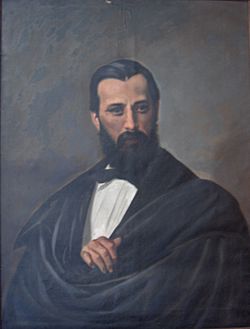José María Vergara y Vergara facts for kids
Quick facts for kids
José María Vergara y Vergara
|
|
|---|---|

Portrait of José María Vergara y Vergara located in the Colombian Academy of Language
|
|
| Born | 19 March 1831 Bogotá, Gran Colombia |
| Died | 9 March 1872 (aged 40) Bogotá, United States of Colombia |
| Occupation | Writer, journalist, diplomat, politician, literary critic, historian |
| Language | Spanish |
| Nationality | Colombian |
| Notable works | Historia de la literatura en Nueva Granada (1867) |
| Notable awards | Literature award José Maria Vergara y Vergara named after him by Government of Colombia |
| Spouse | Saturia Balcázar |
| Children | Ignacia, Francisco José, Mercedes, Concepción y Tadeo |
| Relatives | Eladio Vergara y Vergara |
José María Vergara y Vergara (born March 19, 1831 – died March 9, 1872) was an important Colombian writer, journalist, politician, historian, and diplomat. He is famous for writing the first detailed history of Colombian literature. This book covered authors, their works, and literary styles from 1538 to 1820.
Vergara also helped start and lead the Colombian Academy of Language. He worked with Manuel Antonio Caro and Jose Cuervo. Many people consider him the most important Colombian author of the 19th century. After he passed away in 1887, the President of Colombia created a special literature award named after him.
Contents
José María Vergara's Early Life
José María Vergara y Vergara was born in Bogotá in 1831. His family was old and well-known. He was the sixth of ten children. His parents were Ignacio Manuel de Vergara and Ignacia Vergara Nates.
He spent much of his childhood at the Casablanca Hacienda. This was a large family estate near Madrid, Cundinamarca. This property had been in his family for many years. It often appeared in his stories and writings. Later, the family lost the property due to financial problems.
Family Life and Career Beginnings
In the 1850s, José María moved to Popayán. There, he met Saturia Balcázar. They married in 1854. They had five children: Ignacia, Francisco José, Mercedes, Concepción, and Tadeo. Sadly, Concepción and Tadeo died when they were young.
Vergara worked as a literature professor in Popayán. He also started and edited several newspapers. These papers covered literature and politics. In 1862, he became the treasurer of the Casa de Moneda, which was like a mint.
His Important Literary Works
In 1867, José María Vergara published a big part of his most important book. It was called Historia de la literatura en Nueva Granada (1535-1820). This book was a history of literature in the region. He published two parts of it, but the third part was never finished.
Vergara loved reading works by authors like Fernán Caballero and Miguel de Cervantes. He also wrote many of his own books. Some of his famous works include:
- Historia de la literatura en Nueva Granada (Parts I and II, 1867)
- Anthologies (collections of writings) like Parnaso colombiano and La lira granadina
- Novels such as Novela Americana, which he wrote with Jorge Isaacs and Guillermo Prieto
- A biography about General Antonio Nariño, called Vida y escritos del general Nariño
- Lyric poetry (poems that express feelings) in Versos en borrador (1869)
- Costumbrismo portraits (stories about local customs and people) like Las tres tazas y otros cuentos (1863)
- Novels such as Olivas y aceitunas, todas son unas (1868)
He also had some writings that were not published before he died. These included a novel called Mercedes. He also had Cuadros Políticos o Días Históricos, which was about political events. He started a geography dictionary and a biography dictionary. Two other unfinished novels were Un chismoso and Un odio a muerte.
Newspapers He Founded or Edited
José María Vergara y Vergara was very active in journalism. He helped start or edit several important newspapers:
- La Siesta (Bogotá, 1852): He worked on this paper with Rafael Pombo.
- La Matricaria: Periódico de La Juventud. Colección de Artículos de Costumbres, Revistas y Literatura (Popayán, 1854): This paper was for young people.
- El Mosaico: Miscelánea de Literatura, Ciencias y Música (Bogotá, 1858): He worked with Ricardo Carrasquilla and José Manuel Marroquín on this one.
- El Heraldo: Órgano Del Partido Conservador (Bogotá, 1860): This was a newspaper for the Conservative Party.
- El Cundinamarqués: Periódico Oficial y Órgano de los Intereses del Estado (Bogotá, 1861): This paper was the official voice for the state of Cundinamarca.
Images for kids
See also
In Spanish: José María Vergara y Vergara para niños


